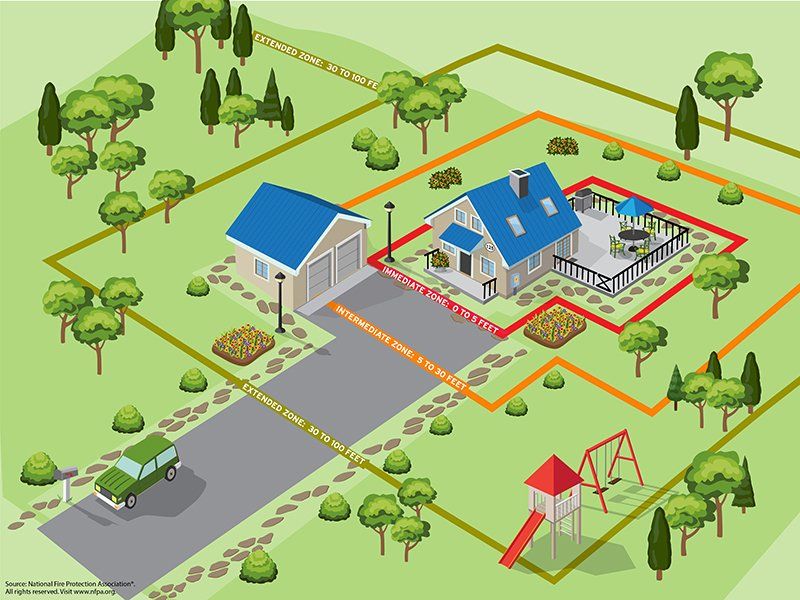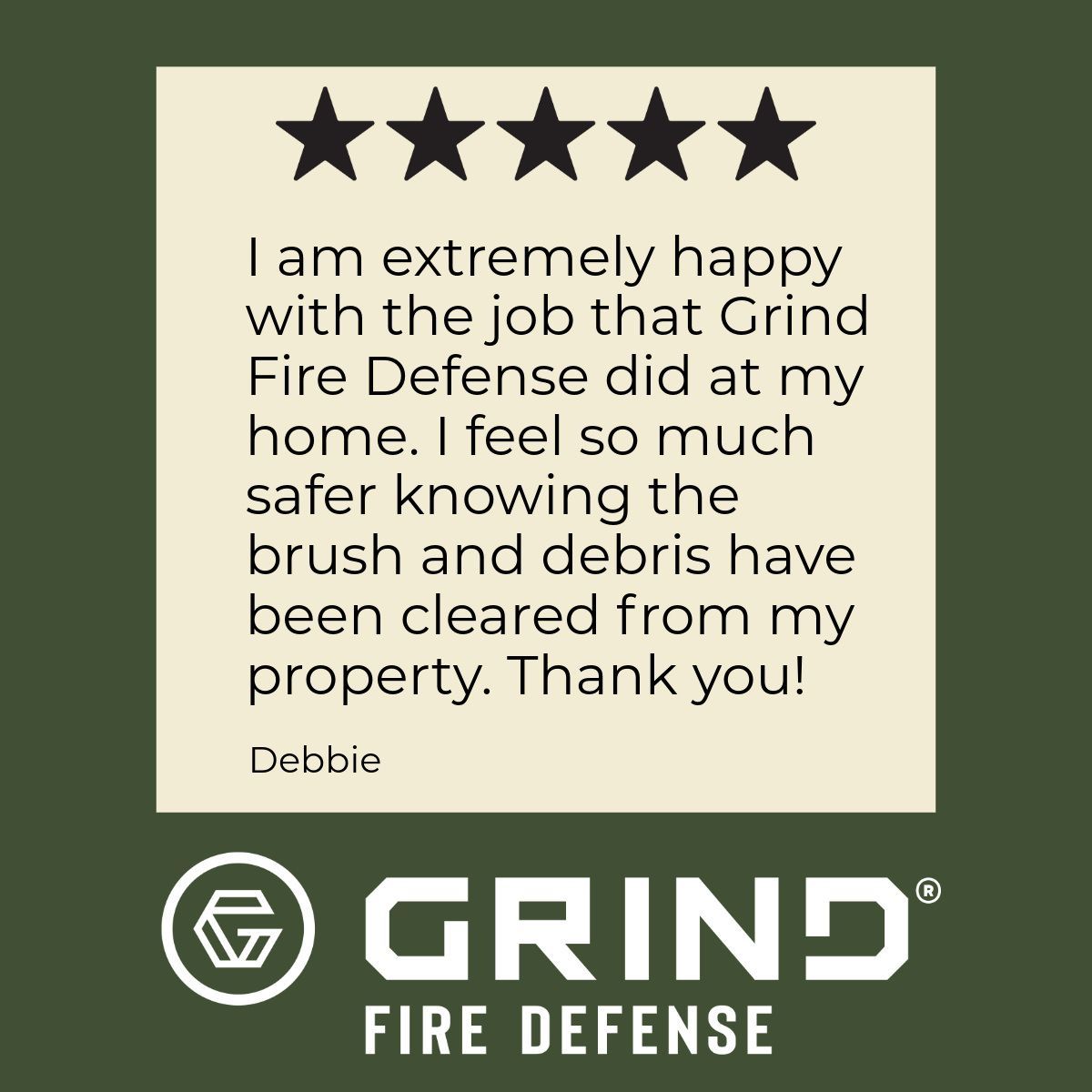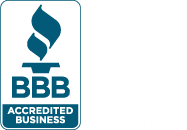The Fuel Reduction Zone
Fire Defensible space Assessment, creation and maintenance for ZONE 2
defensible space
Zone 2
If you live in Northern California, you may be required to have defensible space on your property. Defensible space is a buffer zone between structures and wildland vegetation that aims to reduce the risk of damage.
It’s essential to ensure your property has adequate defensible space to protect yourself and your home from wildfires. The cost of not having enough defensible space can be devastating. Not being prepared could even result in the complete loss of your home.
At
Grind Fire Defense, we offer free preliminary assessments that will help determine what type of maintenance you need for your property. We then create a custom plan based on our assessment findings and provide annual maintenance services to protect your home from wildfires.
What is a Defensible Fire Zone?
A defensible fire zone is an area around a building or structure that has been changed to reduce the risk of wildfire damage. These areas can be created in many ways, such as removing plants, using fire-resistant materials, and installing sprinkler systems. Creating a defensible zone aims to create a buffer around a structure to help stop or slow a wildfire, which can give firefighters a better chance of protecting the area.
Defensible fire zones are usually established in areas at high risk of wildfire, specifically places with dry, flammable plants or frequent wildfires. These areas can be found in rural, suburban, or urban areas.
Zone 2:
The
fuel reduction zone
Defensive fire zone 2 is designed to provide the highest level of protection for the building or structure.
In the fuel reduction zone, remove flammable vegetation to reduce the amount of fuel available for a wildfire. This involves removing trees and other vegetation close to the building. Trimming or pruning trees and shrubs also reduces their fuel load. In some cases, clearing a wider area around the building may also be necessary to create a buffer of non-flammable material.
Creating a fuel reduction zone helps to reduce the risk of wildfire damage and gives firefighters a better chance of protecting the building. It is essential to maintain this zone regularly. Overgrown or poorly maintained landscaping can increase the risk.
This space is needed to slow the spread of wildfire and improve the safety of firefighters defending your home.
This Zone includes the selective thinning/separating of live vegetation not found directly under any tree canopy: ground (4”-10”), cover (10” - 24”), and shrubs (24” - 72”) to break up uniform fuels. This zone requires strategic tree removal mapping to ensure the forest's health and create a park-like setting.
We will remove the latter fuels (up to 6’) and utilize selective timber thinning to create a 10’ horizontal spacing of aerial fuels. The horizontal spacing will be adjusted and catered to the property's slope.
- Cut annual grasses and forbs to maintain a Maximum 4” height.
- Make separation to meet continuous canopy separation.
- Selective timber thinning.
- Removal of later fuels.
- Remove woody surface fuels, and condensed aerial fuels will be removed
- Isolate stumps from other vegetation sources (low-cut stumps)
- Remove downed dead logs and wood debris
- Remove loose surface litter (twigs, bark, cones, and small branches)

Is your home ready for the wildfire season?
In addition to the fuel reduction zone, defensible space also includes other layers of protection. It's best to work on all zones when possible, such as a lean, clean, green zone (zone 1) and an ember-resistant zone (zone 0). The lean, clean, and green zone is an area around the buildings where vegetation has been removed, and fire-resistant building materials and landscaping elements have been used. The ember-resistant zone prevents embers from reaching the building or structure. These zones create a defensible space system to protect your home and property.
Defensible space is an essential tool for protecting buildings and structures from wildfires. Creating defensible space zones around your home and property and implementing protective measures can reduce the risk of wildfire damage. In addition to the reduced risk, it gives firefighters a better chance of protecting your home and other buildings. While removing the risk of wildfire damage altogether is impossible, defensible fire zones can help to provide more excellent protection in high-risk areas. After a wildfire, they can also ensure you have a home and other buildings.
Protect your home Today
Book a free consultation with a Defensible Space Specialist today.


WHat makes GRIND FIRE DEFENSE
the top defensible space service
in Northern CALIFORNIA?
We hire local firefighters on our crews. By choosing Grind Fire Defense, you'll be supporting the folks who help protect us from wildfires.
WE'RE FASTER & SAFER
Our crews will get your property done faster while following all best practices for wildfire prevention.
We do every job right because we want to protect your property, keep firefighters safe, and be a good neighbor.
we KNOW ALL THE REGULATIONS + Higher Standards
We're Fully-Bonded, INsureD & Licensed
As a fully bonded, insured, and licensed service provider, our work is guaranteed & you are protected.
We HIre local firefighters
Shasta Lake Fire Protection District
Cottonwood Fire Protection District
Our certifications in FIRE FIGHTInG & WILDLAND MANAGEMENT
Firefighter I & II (CA/International)
Wildland Firefighter I Academy
Wildland Firefighter I & II
Wildland Fire Chain Saw S-212
Basic Fire Fighter (CalFire/Shasta-Trinity)
64th Firefighter I Academy
Wildland L-180, S-190
Firefighter S131, S130
NFPA Certified Wildfire Mitigation Specialist (CWMS)



